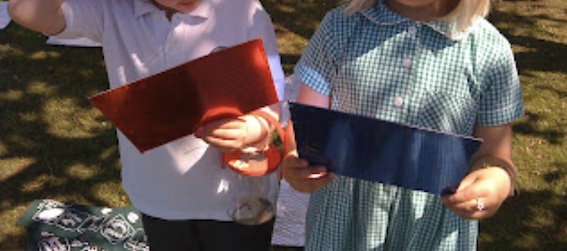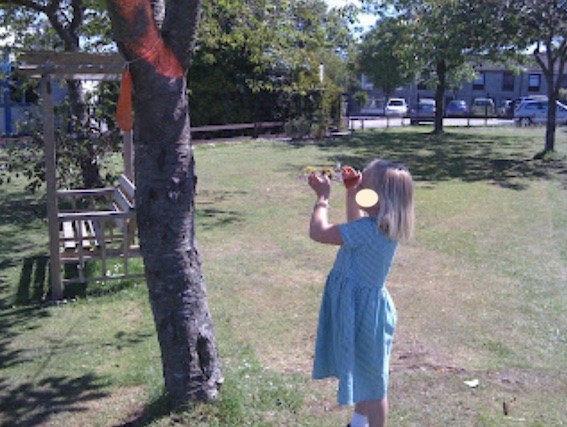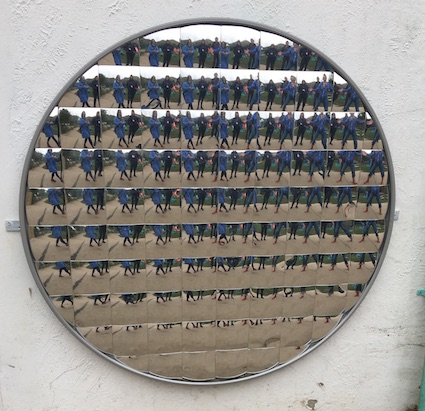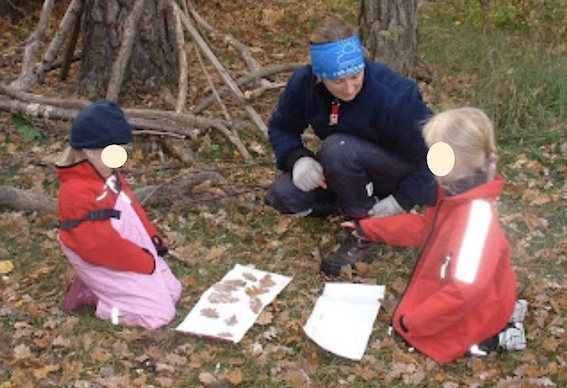Previously I’ve blogged about investigating reflections which is one way into symmetry and can be linked to scientific and artistic explorations. Back in the outdoor space, more specific experiences can be provided for young children based upon their own discoveries in play.
Various reflective surfaces can be created or found. If an outdoor space is being developed think about making symmetrical features. In the nursery below, artificial puddles were part of the design features. Fancy that! The layout is also symmetrical:
CD’s are weatherproof and work if you need light catchers to keep birds away from vegetable patches! Or they make a lovely display, if you have unwanted CDs that need repurposing:
Whilst space blankets are not officially toys, the sound, texture and reflective properties add fun to any outdoor space. Again, you may have an old one tucked away in a first aid kit. Look at how this tree has been dressed up!

These portable seats are bright and have reflective properties. They are made from the insulation material that is put behind radiators – tough aluminium-covered bubble wrap. So looking for off-cuts from electricians:
Mirrors are “must-haves” for symmetry work at some point. Hiding or placing a selection of mirrors at different heights and in different positions helps children explore their environment in different ways. For example, place a mirror under a lightweight log, so that children can lift up the log and see its reflection in the mirror underneath.

If your setting wishes to fix big mirrors outside, then place them in creative ways. For example, have one put where children can see themselves as they move outside. Have another attached to a fence in a little nook or cranny where children may have to crawl or go around a corner to find it. Think about where the sun will be to avoid direct sunlight reflecting off the mirror at certain times of the day. If your outdoor area is small, then use place mirrors to create a feeling of greater light, depth and space.

I’m a fan of coloured mirrors. I think it’s the inner-kitch-within me surfacing. Mind you, children seem equally interested in them. Teach children how to reflect light off a mirror safely. Then they can have fun following the light patterns created outside. Coloured mirrors, provide different colours to follow:

Distorting mirrors such as convex and concave mirrors make investigations interesting. Having a selection of these along with portable mirrors of different sizes, colours and shapes can help so children can observe what they see in different ways.

Natural materials can be used to provide symmetry challenges. Ask children to find a natural object. Then ask them to find another one exactly the same. Discuss similarities and differences between the two objects. A partner activity can happen when one child has to collect a variety of materials and create a simple line pattern. Her partner has to find similar objects and create the symmetrical pattern as illustrated below:

Large scale symmetrical artwork can be undertaken outside. Provide materials for printing patterns – or use feet dipped in paint! There is often a sense of symmetry about children’s pattern making which can be encouraged by providing balanced sets of materials, e.g. building bricks, utensils and tools as well as natural materials.
I know I’ve not covered all the possibilities of symmetry work outside for young children. Please do share any good ideas that you know or have discovered too.
This blog post was originally posted in April 2011.






























Trackbacks/Pingbacks